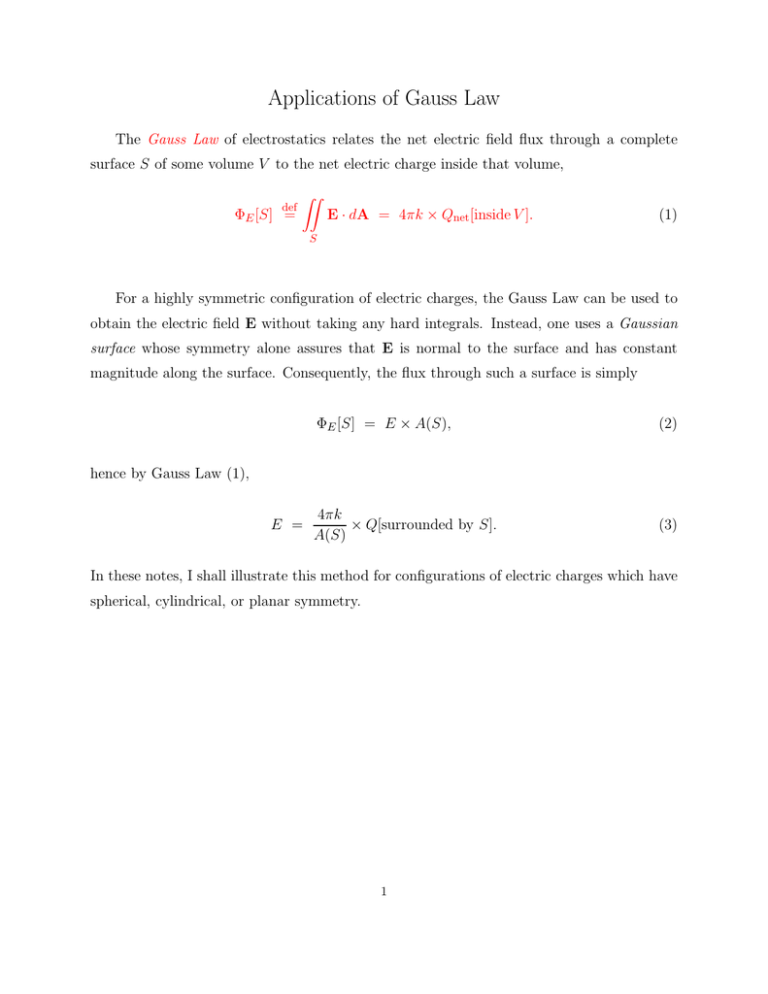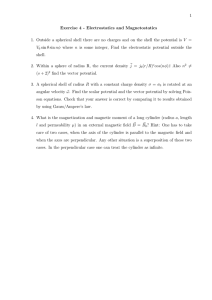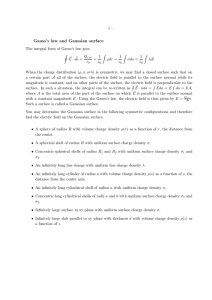Applications of Gauss Law
advertisement

Applications of Gauss Law The Gauss Law of electrostatics relates the net electric field flux through a complete surface S of some volume V to the net electric charge inside that volume, def ΦE [S] = ZZ E · dA = 4πk × Qnet [inside V ]. (1) S For a highly symmetric configuration of electric charges, the Gauss Law can be used to obtain the electric field E without taking any hard integrals. Instead, one uses a Gaussian surface whose symmetry alone assures that E is normal to the surface and has constant magnitude along the surface. Consequently, the flux through such a surface is simply ΦE [S] = E × A(S), (2) 4πk × Q[surrounded by S]. A(S) (3) hence by Gauss Law (1), E = In these notes, I shall illustrate this method for configurations of electric charges which have spherical, cylindrical, or planar symmetry. 1 Spherical Symmetry The spherically symmetric charge configurations include a point charge, a uniform spherical shell of charges, a uniformly charged solid ball, several concentric spherical shells, as well as more exotic configurations where the 3D charge density ρ depends on the radius but not on the direction of the radius-vector. In spherical coordinates (r, θ, φ), dQ = ρ(r) × dVolume = ρ(r) × dr × r 2 dΩ (4) where dΩ = dθ × sin θdφ is the infinitesimal solid angle (in steradians) and ρ(r, \θ, \φ) depends only on the radius but not on the angular coordinates θ or φ. By symmetry, the electric field E of spherically symmetric charges always points in the radial direction — towards the origin, or away from the origin — while its magnitude depends only on the radius, E(r, θ, φ) = E(r only)~ır . (5) To find the radial dependence of E(r) we use the Gauss Law. Let S be a sphere of some radius r centered at the origin. By symmetry, the radial electric field is always perpendicular to S, while its magnitude E(r) stays constant along S. This makes S a Gaussian surface, so the flux through S is simply ΦE [S] = E(r) × A(S) = E(r) × 4πr 2 . (6) E(r) × 4πr 2 = 4πk × Qnet [inside S] (7) inside sphere k def k . E(r) = 2 × Q(r) = 2 × Qnet r r of radius r (8) Hence, by Gauss Law, and therefore 2 Example: Point Charge. For an isolated point charge Q, any sphere surrounding the charge contains the same net charge Q(r) = Q, hence eq. (8) reproduces the Coulomb Law, E(r) = kQ . r2 (9) Example: Thin Spherical Shell. Now consider a thin spherical shell of radius R and uniform surface charge density Qnet dQ = . dA 4πR2 σ = (10) For this shell, a Gaussian sphere of radius r < R contains no charge at all, while a Gaussian sphere of radius r > R contains the whole charge Qnet of the shell, thus Q(r) = 0 for r < R, Qnet for r > R, (11) and therefore E(r) 0 E(r) = kQnet r2 for r < R, (12) for r > R, r In other words, inside the shell there is no electric field, but outside the shell the electric field is the same as if the whole charge was at the center. 3 Example: Solid Ball. For our next example we take a solid ball of radius R and uniform 3D charge density ρ = dQ Qnet = 4π 3 . dV 3 R (13) Again, a Gaussian sphere of radius r > R contains the entire charge of the ball, hence for r > R, E(r) = kQnet , r2 (14) outside the ball, its electric field is the same as if the whole charge was at the center of the ball. This is an example of a general rule: outside any spherically symmetric charged body, its electric field is the same as if the whole charge was at the center. But inside the body, only the charges inside radius r contribute to the E(r). For the solid ball, the Gaussian sphere of radius r < R contains charge Q(r) = ρ × V ball of radius r = ρ× 4π 3 r3 r = Qnet × 3 . 3 R (15) Consequently, the electric field at radius r < R is E(r) = Qnet r 3 kQnet r k × = × . 2 3 2 r R R R (16) Thus, inside the ball, the electric field increases linearly with the radial coordinate, while outside the ball it decreases as 1/r 2 . Altogether, E(r) (17) r 4 Example: Non-Uniform density. Finally, consider a solid ball of radius R whose charge density depends on the radial coordinate as ρ(r) = C × r α (18) for some constants C and α. The net charge of such a ball is ZR Qnet = ρ(r) × dVolume(r) = 0 ZR Cr α × 4πr 2 dr 0 = 4πC × ZR r α+2 dr = 4πC × Rα+3 α+3 (19) 0 4π CRα+3 . = α+3 Again, outside the ball the electric field is simply the Coulomb field of the net charge at the center of the ball, for r > R, kQnet . r2 E(r) = (20) But inside the ball, we have a more complicated formula. Indeed, the charge inside a Gaussian sphere of radius r < R is Q(r) = Zr ′ ′ ρ(r ) × dVolume(r ) = 0 = Zr Cr ′α × 4πr ′2 dr ′ (21) 0 4π Cr α+3 = Qnet × α+3 R r α+3 , hence E(r) = r α+3 kQ(r) kQnet r α+1 1 = kQ × = × × . net r2 R r2 R2 R 5 (22) Cylindrical Symmetry Cylindrically symmetric configurations of electric charges include a long thin rod, a long hollow cylinder, several coaxial cylindrical shells (like a coaxial cable), as well as more general systems which are uniform and infinitely long in one dimension and axially symmetric in the other two dimensions. In cylindrical coordinates (rc , φ, z), dQ = ρ(rc ) × dV = ρ(rc ) × drc × rc dφ × dz (23) where the charge density ρ(rc , \φ, \z ) depends only on the cylindrical radius rc but not on the angle φ or the lengthwise coordinate z. By symmetry, the electric field of a cylindrically symmetric charge configuration always points directly away from the cylinder’s axis or directly towards the axis, i.e. it has no z or φ components but only the rc component. Also, the magnitude of the electric field depends only on the cylindrical radius rc , E(rc, φ, z) = E(rc only)~ırc . (24) The Gaussian surfaces for such an electric field are cylinders C of generic radii r and lengths L but always coaxial with the charge distribution. For completeness sake, such a surface comprises both the outside cylinder at fixed rc = r and the circular endcaps at fixed z = z1 or z = z2 , However, on the endcaps the electric field (24) lies parallel to the endcaps instead of crossing them, so the flux through the endcaps is zero. Instead, the entire flux comes through the 6 outer cylinder where E stays normal to the surface and its magnitude stays constant E(r). Altogether, the net flux through the cylinder C is ΦE [C] = E(rc = r) × A(C) = E(rc = r) × 2πrL. (25) By Gauss Law, this implies 2πrL × E(rc = r) = 4πk × Qnet inside cylinder of length = L and radius = r (26) and therefore 2k inside cylinder of E(rc ) = × Qnet rL length = L and radius = rc (27) By translational symmetry along the cylinder axis, the charge inside the cylinder is always proportional to its length L, so let us define the linear charge density inside a given radius rc , 1 inside cylinder of λ(rc ) = × Qnet L length = L and radius = rc def (28) In terms of this linear density, 2k λ(rc ) . rc E(rc ) = (29) Example: Thin Rod. Consider an infinitely long, infinitely thin rod of uniform linear charge density λ. Any Gaussian cylinder containing this rod has net charge Q = λ × L regardless of the cylinder’s radius. In terms of eq. (28), this means λ(rc ) ≡ λ for any rc > 0, hence by the Gauss Law equation (29) E(rc ) = 2kλ rc =⇒ E = 2kλ ~ır . rc c (30) Note the agreement of this formula with the result of direct integration of Coulomb fields over the length of the rod. But thanks to the Gauss Law, this time we did not have to do any integrals. 7 Example: Thin Cylindrical Shell. For our next example, consider an infinitely long thin cylindrical shell of radius R with a uniform surface charge density σ ≡ dQ λnet = . dA 2πR (31) For this shell, a Gaussian cylinder of radius rc < R contains no electric charge at all, while a cylinder of radius rc > R contains charge Q = λL. In terms of λ(rc ) this means λ(rc ) = 0 for r < R, λnet for r > R, (32) and therefore E(rc ) 0 E(rc ) = 2kλnet rc for rc < R, (33) for rc > R, rc In other words, inside the shell there is no electric field, but outside the shell the electric field is the same as if the whole charge was on the axis. In general, outside any cylindrically symmetric charged body, the electric field is the same as outside a thin rod of the same net charge density λnet . Example: Solid Cylinder. Now consider an infinitely long solid cylinder of radius R and uniform 3D charge density ρ ≡ dQ λnet = . dV πR2 (34) This time, a Gaussian cylinder of radius rc > R contains charge Q = L × λnet , while a 8 Gaussian cylinder of radius rc < R contains non-zero but smaller charge Q = ρ × πrc2 L = Lλnet × rc2 R2 (35) In terms of λ(rc ), this means 2 r λ(rc ) = λnet × R2 1 for rc < R, (36) for rc > R, and therefore for rc < R, E(rc ) = 2kλnet × for rc > R, 2kλnet , E(rc ) = rc rc2 2kλnet rc 1 = × × , R 2 rc R R (37) inside the cylinder the electric field grows linearly with the radius as rc while outside the cylinder it decreases as 1/rc , E(rc ) (38) rc 9 Example: Thick Cylindrical Shell. This time, consider a thick cylindrical shell of inner radius R1 and outer radius R2 , R1 R2 and uniform 3D charge density ρ, hence net linear charge density λnet = ρ × πR22 − πR12 . (39) This time, a Gaussian cylinder of radius smaller than the inner radius of the shell contains no electric charge at all, and there is no electric field in the hollow inside the cylinder, for rc < R1 , λ(rc ) = 0 =⇒ E(rc ) = 0, (40) On the other hand, the Gaussian cylinder of radius larger than the outer radius of the shell contains the entire linear charge density of the shell, thus for rc > R2 , λ(rc ) = λnet =⇒ E(rc ) = 2kλnet , rc (41) the electric field outside the shell is is similar to the field of a thin rod of the same λnet . Finally, to find the electric field within the thickness of the shell, we use a Gaussian cylinder of radius R1 < rc < R2 . The linear charge density inside this Gaussian cylinder is λ(rc ) = ρ × πrc2 − πR12 = λnet × rc2 − R12 , R22 − R12 (42) hence E(rc ) = 2kλnet × 10 rc2 − R12 1 × . R22 − R12 rc (43) Altogether, E(rc ) (44) rc Planar Symmetry Charge configurations with planar symmetry include uniform 2D sheets, uniform slabs of finite thickness, as well as “sandwiches” of such sheets and slabs. In Cartesian coordinates (x, y, z), a general configuration with planar symmetry has 3D charge density ρ(x, y, z) which depends only on z but not x or y. By symmetry, the electric field of such a configuration is parallel to the z axis and its magnitude depends only on the z coordinates but not on x or y, E(x, y, z) = Ez (z only)~ız . (45) For simplicity, let me assume an additional upside-down symmetry z → −z, thus ρ(−z) = ρ(+z) =⇒ Ez (−z) = −Ez (+z). (46) For charge configurations with planar and upside-down symmetries, the simplest Gaussian surfaces to use are brick-like parallelepipeds with top and bottom surfaces at +z and −z and horizontal area A = ∆x × ∆y. Since the electric field is vertical everywhere, it has no flux through the four vertical sides of such a Gaussian brick, so the entire flux through the brick comes from the horizontal top and bottom surfaces. Thus, ZZ ZZ ΦE [brick] = dx dy Ez (x, y, +z) − dx dy Ez (x, y, −z) top (47) bot where the − sign between the two integrals comes from opposite directions of the insideto-outside normals to the top and bottom surfaces, ntop = (0, 0, +1), nbot = (0, 0, −1). 11 Fortunately, the integrals in eq. (47) are trivial since the electric field does not depend on x and y, hence ΦE [brick] = A × Ez (+z) − Ez (−z) . (48) Finally, in light of the upside-down symmetry (46), ΦE [brick] = 2A × Ez (+z). (49) By Gauss Law, this flux is related to the net electric charge of the Gaussian brick, inside brick 2AEz (+z) = 4πk × Qnet A × (−z to + z) (50) Since the net charge inside such a brick is always proportional to the bricks horizontal area A, let’s define the net surface density of charge between −z and +z, Z+z 1 inside brick σ(z) = = ρ(z ′ ) dz ′ . × Qnet A A × (−z to + z) def (51) −z In terms of this surface density, Ez (+z) = +2πk × σ(z), Ez (−z) = −2πk × σ(z). (52) Example: Thin Sheet. As a first example, consider an infinitely thin charged sheet of uniform surface charge density σnet . For this sheet, any Gaussian brick has net charge Q = σnet × A and therefore σ(z) ≡ σnet . Consequently, the electric field of this sheet is Ez (+z) = +2πkσnet , Ez (−z) = −2πkσnet , for any z > 0, (53) or in other words, E = 2πkσtot sign(z)~ız . (54) Note: this is the same formula we had earlier obtained by integrating the Coulomb field of infinitesimal point charges all over the infinite 2D sheet. But this time, we did not have to integrate anything. 12 Example: Thick Slab. For our second example, consider a slab of finite thickness D and uniform 3D charge density ρ = σnet . D (55) For this charge configuration, a Gaussian brick of area A and thickness 2z < D has net charge Q = ρ × A × 2z, hence σ(z) = ρ × 2z = σnet × 2z D (56) and therefore for 0 < z < D , 2 Ez (+z) = +2πk×σnet × 2z +z = 4πkσnet × , D D Ez (−z) = 4πkσnet × −z . D (57) In other words, the electric field inside the slab is for − D D < z < + , 2 2 E(z) = 4πkρz~ız = 2πkσnet z ~ız . D/2 (58) On the other hand, the Gaussian brick or thickness 2z > D has net charge Q = σnet × A, hence σ(z) = σnet and therefore for z > D , 2 Ez (+z) = +2πkσnet , Ez (−z) = −2πkσnet . (59) In other words, the electric field outside the slab is for |z| > D , 2 E(z) = 2πkσnet sign(z)~ız (60) which is the same as the field of a thin sheet of the same net surface charge density σnet . 13 Altogether, Ez z Generalization: No Upside-Down Symmetry. Now consider a configuration of electric charges which has planar symmetry but not the upside-down z → −z symmetry (46), for example an asymmetric ‘sandwich’ of several charged slabs with different thicknesses and charge densities. The electric field of such a configuration has direction along the z axis and depends only on the z coordinate as in eq. (45), but there is no general relation between E(+z) and E(−z). The Gaussian surfaces for such electric fields are bricks with bottom surface at z1 and top surface at z2 , but now z1 and z2 are no longer related by a symmetry. For any such brick, the electric flux through the 4 vertical sides vanishes since the electric field is vertical, so the net flux comes through the top and bottom surfaces, ΦE [brick] = ZZ dx dy (0, 0, +1) · E(x, y, z2 ) + top ZZ dx dy (0, 0, −1) · E(x, y, z1 ) (61) bot = +A × Ez (z2 ) − A × Ez (z1 ). The Gauss Law relates this flux to the net electric charge inside the brick, or after dividing by the horizontal area A, to the Zz2 1 inside = ρ(z) dz. σ(z1 , z2 ) = = Q A brick def (62) z1 Specifically, inside ΦE [brick] = 4πk × Q brick 14 = 4πkA × σ(z1 , z2 ) (63) and therefore Ez (z2 ) − Ez (z1 ) = 4πkσ(z1 , z2 ) = 4πk × Zz2 ρ(z) dz. (64) z1 By itself, this formula does not give us the electric field. But if we know the field at any particular value of z, then eq. (64) gives us the electric field everywhere else. Mathematically, eq. (64) is the formal solution of the differential equation dEz = 4πk × ρ(z), dz (65) which is the special case (for systems with planar symmetry) of the Maxwell’s electrostatic equation ∇·E = ∂Ey ∂Ez ∂Ex + + = 4πkρ(x, y, z). ∂x ∂y ∂z 15 (66)



